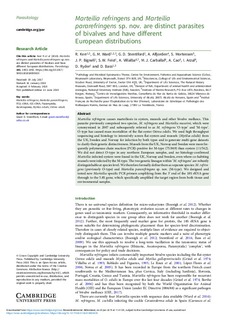| dc.contributor.author | Kerr, Rose C. | |
| dc.contributor.author | Ward, Georgia M. | |
| dc.contributor.author | Stentiford, Grant D. | |
| dc.contributor.author | Alfjorden, Anders | |
| dc.contributor.author | Mortensen, Stein | |
| dc.contributor.author | Bignell, John P. | |
| dc.contributor.author | Feist, Stephen W. | |
| dc.contributor.author | Villalba, Antonio | |
| dc.contributor.author | Carballal, María J. | |
| dc.contributor.author | Cao, Asun | |
| dc.contributor.author | Arzul, Isabelle | |
| dc.contributor.author | Ryder, David | |
| dc.contributor.author | Bass, David | |
| dc.date.accessioned | 2019-01-28T10:13:42Z | |
| dc.date.available | 2019-01-28T10:13:42Z | |
| dc.date.created | 2019-01-11T12:17:41Z | |
| dc.date.issued | 2018 | |
| dc.identifier.citation | Parasitology. 2018, 145 (11), 1483-1492. | nb_NO |
| dc.identifier.issn | 0031-1820 | |
| dc.identifier.uri | http://hdl.handle.net/11250/2582580 | |
| dc.description.abstract | Marteilia refringens causes marteiliosis in oysters, mussels and other bivalve molluscs. This parasite previously comprised two species, M. refringens and Marteilia maurini, which were synonymized in 2007 and subsequently referred to as M. refringens ‘O-type’ and ‘M-type’. O-type has caused mass mortalities of the flat oyster Ostrea edulis. We used high throughput sequencing and histology to intensively screen flat oysters and mussels (Mytilus edulis) from the UK, Sweden and Norway for infection by both types and to generate multi-gene datasets to clarify their genetic distinctiveness. Mussels from the UK, Norway and Sweden were more frequently polymerase chain reaction (PCR)-positive for M-type (75/849) than oysters (11/542). We did not detect O-type in any northern European samples, and no histology-confirmed Marteilia-infected oysters were found in the UK, Norway and Sweden, even where co-habiting mussels were infected by the M-type. The two genetic lineages within ‘M. refringens’ are robustly distinguishable at species level. We therefore formally define them as separate species: M. refringens (previously O-type) and Marteilia pararefringens sp. nov. (M-type). We designed and tested new Marteilia-specific PCR primers amplifying from the 3’ end of the 18S rRNA gene through to the 5.8S gene, which specifically amplified the target region from both tissue and environmental samples. | nb_NO |
| dc.language.iso | eng | nb_NO |
| dc.title | Marteilia refringens and Marteilia pararefringens sp. nov. are distinct parasites of bivalves and have different European distributions | nb_NO |
| dc.type | Journal article | nb_NO |
| dc.type | Peer reviewed | nb_NO |
| dc.description.version | publishedVersion | nb_NO |
| dc.source.pagenumber | 1483-1492 | nb_NO |
| dc.source.volume | 145 | nb_NO |
| dc.source.journal | Parasitology | nb_NO |
| dc.source.issue | 11 | nb_NO |
| dc.identifier.doi | 10.1017/S003118201800063X | |
| dc.identifier.cristin | 1654847 | |
| cristin.unitcode | 7431,17,0,0 | |
| cristin.unitname | Sykdom og smittespredning | |
| cristin.ispublished | true | |
| cristin.fulltext | original | |
| cristin.qualitycode | 1 | |
